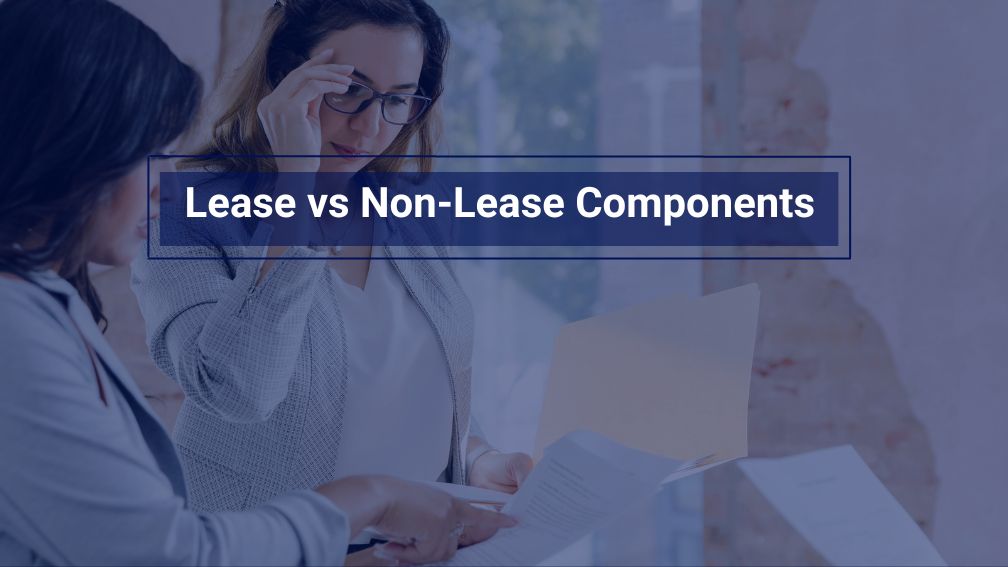
In the world of lease accounting under the new lease accounting standard, ASC 842, differentiating between lease and non-lease components is critical for accurately reporting financial information. Let’s delve deeper into this aspect to gain a comprehensive understanding.
Lease components primarily encompass elements of the contract that grant the lessee the right to use an identified asset over a specific period. When the lease commencement date is determined, the lessee should record the ROU asset & lease liability on the balance sheet at the present value of the minimum lease payments. This marks the beginning of the lessee’s financial reporting obligations related to the lease. These components can significantly impact the lessee’s financial obligations and are vital for presenting a complete financial picture.
Non-lease components, as the name suggests, encompass elements of the contract that do not directly relate to the right to use the underlying asset. These components might provide additional services or rights, and understanding their distinction from lease components is crucial for accurate financial reporting.
The practical expedient bestows the privilege of streamlining the lease accounting process by obviating the segregation of lease and non-lease components, if the lease agreement meets the criteria for a substantive substitution right. This judicious accounting policy election can potentially save valuable time and effort in allocating payments between these components.
Nonetheless, it behooves the astute finance professional to exercise sagacious judgment and diligently document the assessment. Consideration of various factors, such as the nature and impact of the substantive substitution right, the likelihood of its exercise, and the economic implications, is indispensable in the discernment process. Compliance with disclosure requirements is equally pivotal, with transparent communication of the practical expedient’s effects in the financial statements.
Common Area Maintenance (CAM) expenses play a significant role in lease accounting and are an important aspect to consider when distinguishing between lease and non-lease components under ASC 842.
1. CAM is a Non-lease Component: Common Area Maintenance (CAM) charges typically cover expenses related to the maintenance and operation of shared spaces within a property, such as common lobbies, hallways, parking lots, landscaping, and security. Since these charges do not directly grant the lessee the right to use an identified asset (the leased space), they are considered non-lease components.
2. Separate Accounting Treatment: Non-lease components, including maintenance costs, should be accounted for separately from lease components under ASC 842. They should not be included in the measurement of the “ROU asset & lease liability,” as they do not represent the lessee’s right to use the underlying leased asset.
3. Allocating CAM Expenses: Lessees typically share CAM expenses with other tenants in the property. To properly allocate these expenses, companies must assess the proportional share attributable to their leased space and account for it as a non-lease component expense in the income statement.
4. Disclosures: Proper disclosure of CAM expenses in the financial statements is essential for transparency and compliance with ASC 842. Finance professionals should provide a clear breakdown of lease and non-lease components, including any CAM charges incurred during the lease term.
A lease component example is a specific element within a lease agreement that conveys the right to use an identified asset. Lease components are the building blocks of lease accounting under ASC 842 and represent essential components of the lease arrangement.
Base Rent as a Lease Component: Base rent is a common and straightforward example of a lease component. It hold economic substance in the representation the fixed, non-cancelable lease payments that a lessee is required to pay to the lessor throughout the lease term. The base rent is typically outlined in the lease agreement and remains consistent over the agreed-upon lease period.
For instance, suppose a company signs a lease agreement for a retail space with a fixed monthly base rent of $3,000 for a ten-year lease term. In this case, the base rent of $3,000 per month is a lease component, as it conveys the right to use the specified retail space during the lease term.
As a lease component, base rent contributes to the overall financial obligations of the lessee and is recognized as part of the “minimum lease payments” when applying ASC 842 lease accounting standards. It is an integral part of the lease arrangement and must be accounted for appropriately in the lessee’s financial statements.
Discerning between lease and non-lease components under ASC 842 is fundamental for accurate lease accounting. Lease components, such as the ROU asset and lease liability, along with minimum and variable lease payments, form the core of lease-related financial obligations. On the other hand, non-lease components, including base rent, separate contracts, and recognition and measurement requirements, represent additional services or rights beyond the asset usage.
By comprehending the nuances of these components, finance professionals can ensure compliance with the accounting standard and present a comprehensive financial picture. As lease accounting continues to evolve, mastering the distinction between lease and non-lease components becomes all the more important for making informed business decisions and fostering transparency in financial reporting.
Lauren Covell is a Certified Public Accountant who currently lives in St. Louis, Missouri. She started her career in the PwC audit practice. After PwC, she joined a consulting firm and assisted companies in navigating complex technical accounting matters and streamlined their monthly close processes. Prior to joining Occupier, she was responsible for implementing ASC 842 for a vast portfolio of retail and equipment leases at a high growth consumer products company. Lauren is also passionate about collaborating with others to optimize solutions and creating win-wins for every stakeholder in the process